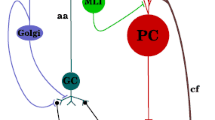Simple spikes and complex spikes are two distinguishing features in neurons of the cerebellar cortex; the motor learning and memory processes are dependent on these firing patterns. In our research, the detailed firing behaviors of Purkinje cells were investigated using a computer compartmental neuronal model. By means of application of numerical stimuli, the abundant dynamical properties involved in the multifarious firing patterns (such as the Max-Min potentials of each spike and period-adding/perioddoubling bifurcations) appeared. Neuronal interspike interval (ISI) diagrams, frequency diagrams, and current-voltage diagrams for different ions were plotted. Finally, Poincaré mapping was used as a theoretical method to markedly distinguish timing of the above firing patterns. Our simulation results indicated that firing of Purkinje cells varies dynamically depending on different electrophysiological parameters of these neurons, and the respective properties may play significant roles in the formation of the mentioned characteristics of dynamical firings in the coding strategy for information processing and learning.
Similar content being viewed by others
References
D. Purves, G. J. Augustine, D. Fitzpatrick, et al., Neuroscience (4th edition), Sinauer Associates, Sunderland (MA) (2008).
R. D Traub, S. J Middleton, T. Knöpfel, and M. A. Whittington, “Model of very fast (>75 Hz) network oscillations generated by electrical coupling between the proximal axons of cerebellar Purkinje cells,” Eur. J. Neurosci., 28, No. 8, 1603-1616 (2008).
J. I. Wadiche and C. E. Jahr, “Multivesicular release at climbing fiber-Purkinje cell synapses,” Neuron, 32, No. 2, 301-313 (2001).
H. Anwar, S. Hong, and E. D. Schutter, “Controlling Ca2+-activated K+ channels with models of Ca2+ buffering in Purkinje cells,” The Cerebellum, 11, No. 3, 681-693 (2012).
M. A. Kramer, R. D. Traub, and N. J. Kopell, “New dynamics in cerebellar Purkinje cells: torus canards,” Phys. Rev. Lett., 101, No. 6, 068103 (2008).
A. M. Swensen and B. P. Bean, “Ionic mechanisms of burst firing in dissociated Purkinje neurons,” J. Neurosci., 23, No. 29, 9650-9663 (2003).
I. M. Raman and B. P. Bean, “Ionic currents underlying spontaneous action potentials in isolated cerebellar Purkinje neurons,” J. Neurosci., 19, No. 5, 1663-1674 (1999).
A. Roth and M. Häusser, “Compartmental models of rat cerebellar Purkinje cells based on simultaneous somatic and dendritic patch-clamp recordings,” J. Physiol., 535, 445-472 (2001).
W. Akemann and T Knopfel, “Interaction of Kv3 potassium channels and resurgent sodium current influences the rate of spontaneous firing of Purkinje neurons,” J. Neurosci., 26, No. 17, 4602-4612 (2006).
W. M. Yamada, C. Koch, and P. R. Adams, Methods in neuronal modeling, Cambridge: MIT Press, Cambridge, Massachusetts, London, England (1987).
A. L. Hodgkin, A. F Huxley, “Currents carried by sodium and potassium ions through the membrane of the giant axon of Loligo,” J. Physiol., 116, 449-472 (1952).
E. D. Schutter and J. M. Bower, “An active membrane model of the cerebellar Purkinje cell. 1. Simulation of current clamps in slice,” J. Neurophysiol., 71, No. 1 375-400 (1994).
T. Miyasho, H. Takagi, H. Suzuki, et al., “Low-threshold potassium channels and a low-threshold calcium channel regulate Ca2+ spike firing in the dendrites of cerebellar Purkinje neurons: A modeling study,” Brain Res., 891, 106-115 (2001)
U. Wolf, M. J. Rapoport, and T. A. Schweizer, “Evaluating the affective component of the cerebellar cognitive affective syndrome,” J. Neuropsychiat. Clin. Neurosci., 21 No. 3, 245-53 (2009).
M. D. Womack, C. Chevez, and K. Khodakhah, “Calcium-activated potassium channels are selectively coupled to P/Q-type calcium channels in cerebellar Purkinje neurons,” J. Neurosci., 24, No. 40, 8818-8822 (2004).
P. Wang, Q. h. Song, Q. M Zeng, et al., “The research about the inductance characteristics of potassium channel,” Beijing Biomed. Engineer, 22, No. 1, 77-79 (2003).
Y. Loewenstein, S. Mahon, P. Chadderton, et al., “Bistability of cerebellar Purkinje cells modulated by sensory stimulation,” Nat. Neurosci., 8, 202-211 (2005).
B. Fakler and J. P. Adelman, “Control of K(Ca) channels by calcium nano/microdomains,” Neuron, 59, No. 6, 873-881 (2008).
Author information
Authors and Affiliations
Corresponding author
Rights and permissions
About this article
Cite this article
Zhang, X.C., Liu, S.Q., Ren, H.X. et al. Dynamic Properties of Purkinje Cells Having Different Electrophysiological Parameters: a Model Study. Neurophysiology 47, 2–10 (2015). https://doi.org/10.1007/s11062-015-9489-y
Received:
Published:
Issue Date:
DOI: https://doi.org/10.1007/s11062-015-9489-y




